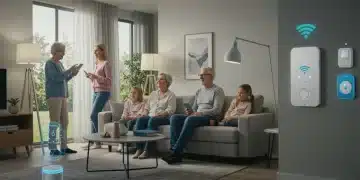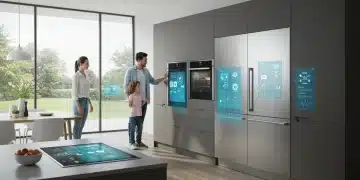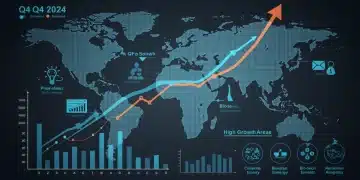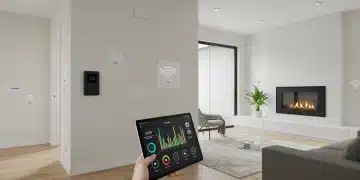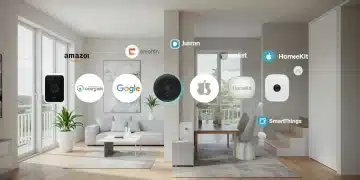Smart Lighting: 2025 Innovations for Enhanced Home Automation
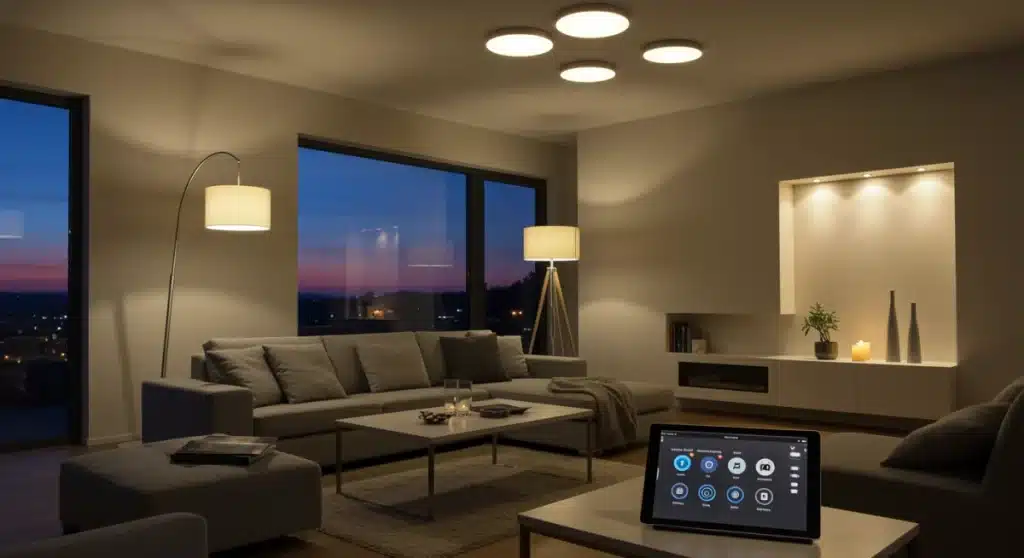
Recent updates reveal significant advancements in smart lighting innovations for 2025, focusing on enhanced home automation through AI integration, predictive illumination, and sustainable solutions, revolutionizing the modern living environment.
As of late 2024, the landscape of home automation is rapidly evolving, with significant breakthroughs shaping smart lighting innovations 2025. These advancements promise not just convenience but a fundamental shift in how we interact with our living spaces, making homes more intuitive, energy-efficient, and responsive to our daily needs.
Next-Generation AI Integration in Smart Lighting
The core of 2025’s smart lighting advancements lies in its deeper integration with artificial intelligence. This isn’t just about voice commands; it’s about systems learning and adapting to occupant behavior, environmental changes, and even personal wellness goals. AI-driven lighting is now moving beyond simple scheduling to predictive illumination.
Leading manufacturers are incorporating sophisticated algorithms that analyze patterns of light usage, occupancy, and external factors like natural light availability. This allows smart lighting systems to anticipate needs, adjusting brightness and color temperature proactively to optimize comfort and energy consumption.
Predictive Lighting Algorithms
New predictive algorithms leverage machine learning to create a truly responsive lighting environment. These systems can, for instance, gradually increase light intensity as natural light fades, mimicking a natural sunset or sunrise indoors. This capability is crucial for promoting healthier circadian rhythms for residents.
- Behavioral Learning: Systems now learn individual and household routines, optimizing light scenes automatically.
- Environmental Sensing: Integration with external weather data and internal light sensors ensures optimal illumination regardless of conditions.
- Wellness Optimization: Light schedules are tailored to support sleep, wakefulness, and overall mood, adapting to individual user profiles.
Advanced Connectivity and Interoperability Standards
One of the most critical developments for 2025 is the push towards universal connectivity standards, addressing a long-standing challenge in home automation. The goal is seamless interoperability between devices from various manufacturers, ensuring that smart lighting systems can communicate effortlessly with other smart home components.
Matter, the new industry-backed connectivity standard, is playing a pivotal role in this evolution. As of recent updates, more and more smart lighting products are shipping with Matter certification, promising an end to compatibility headaches and fostering a truly integrated smart home ecosystem. This means easier setup, more reliable performance, and greater flexibility for consumers.
The Role of Matter in Smart Lighting
Matter’s adoption is accelerating, with major players in the smart home market actively supporting its rollout. This standard allows devices to connect over Wi-Fi, Ethernet, and Thread, offering robust and low-latency communication. For smart lighting, this translates into instant responses and synchronized actions across an entire home, regardless of brand.
- Unified Control: Manage all Matter-certified smart lights via a single app or hub, simplifying user experience.
- Enhanced Reliability: Thread-based networks create a self-healing mesh, ensuring consistent connectivity even if one device goes offline.
- Future-Proofing: Devices compliant with Matter are designed to be forward-compatible, accommodating future innovations and updates.
Energy Efficiency and Sustainability at the Forefront
With increasing global emphasis on sustainability, smart lighting innovations for 2025 are heavily focused on maximizing energy efficiency and minimizing environmental impact. This goes beyond just using LED bulbs; it involves intelligent energy management and the use of eco-friendly materials.
New smart lighting systems are incorporating advanced occupancy sensors, daylight harvesting capabilities, and sophisticated energy monitoring tools. These features not only reduce electricity consumption but also provide users with detailed insights into their energy usage, empowering them to make more informed decisions about their home’s environmental footprint.
Eco-Conscious Lighting Solutions
Manufacturers are exploring sustainable materials for fixtures and packaging, alongside developing longer-lasting components to reduce waste. The integration of renewable energy sources, such as solar-powered outdoor smart lighting, is also gaining traction, offering completely off-grid solutions for certain applications.
Many systems now offer granular control over individual lights or zones, allowing users to dim lights or turn them off in unoccupied areas, significantly cutting down on wasted energy. This level of precision was previously difficult to achieve without complex wiring, but modern wireless protocols simplify implementation.
Human-Centric Lighting and Wellness Integration
The trend towards human-centric lighting (HCL) is intensifying in 2025, with smart lighting systems designed to actively promote human well-being. This involves dynamic adjustment of light color, intensity, and timing to align with natural circadian rhythms, enhancing mood, productivity, and sleep quality.
Beyond traditional HCL, new innovations include integration with wearable devices and health monitoring systems. This allows smart lights to respond to individual biometric data, such as heart rate or sleep patterns, to create an optimal lighting environment tailored to the user’s current physiological state. This personalized approach marks a significant leap in home automation.
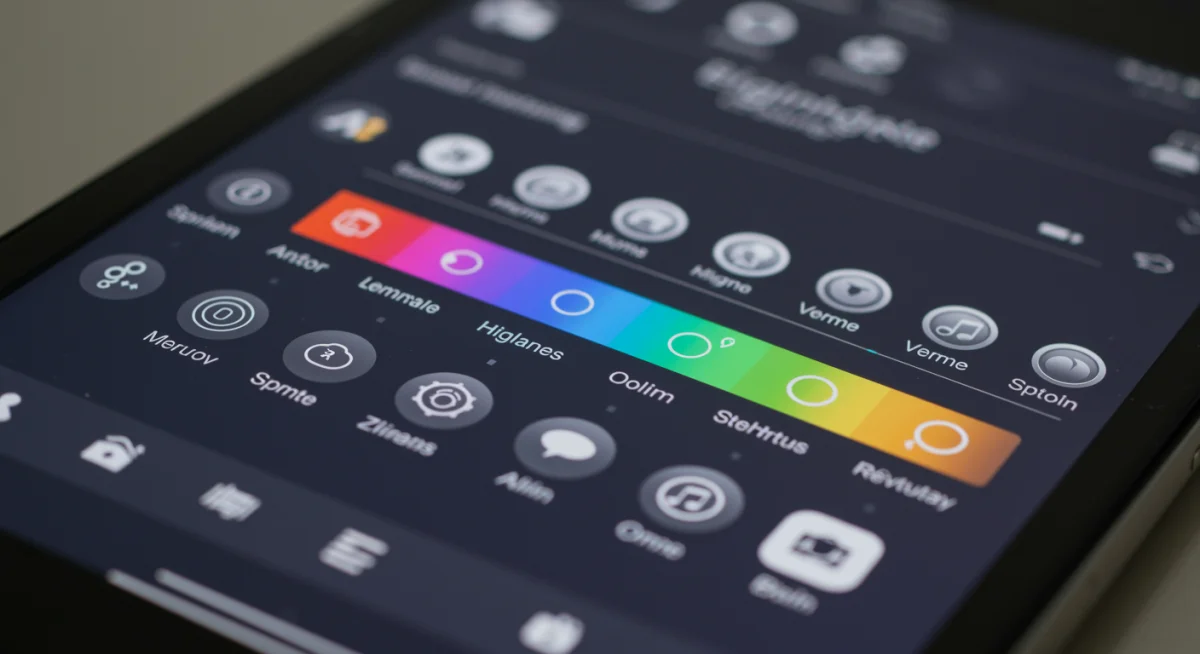
Personalized Light Experiences
The ability to create highly personalized light scenes is now a standard expectation. Users can program specific light sequences for waking up, working, relaxing, or sleeping, all designed to support their natural biological clock. These settings can be easily adjusted via intuitive apps or voice commands.
- Circadian Rhythm Support: Automated light changes mimic natural daylight cycles, improving sleep and energy levels.
- Mood Enhancement: Customizable color temperatures and brightness levels to suit various activities and personal preferences.
- Adaptive Environments: Lights adjust based on real-time biometric data, such as heart rate or activity levels, for ultimate comfort.
Enhanced Security and Privacy Features
As smart homes become more interconnected, the importance of robust security and privacy features cannot be overstated. Smart lighting innovations 2025 are addressing these concerns with advanced encryption protocols, secure local processing, and transparent data handling policies.
Manufacturers are implementing end-to-end encryption for data transmitted between devices and cloud services. Furthermore, many systems now offer options for local control, allowing users to manage their lighting without relying on internet connectivity, thus reducing potential vulnerabilities. Regular security updates are also becoming standard practice to protect against emerging threats.
Data Protection in Smart Lighting
Privacy controls are becoming more granular, giving users greater authority over what data their smart lighting systems collect and how it is used. This includes clear opt-in/opt-out options for data sharing and simplified methods for reviewing and deleting personal data collected by devices.
- Advanced Encryption: All data communication is secured with industry-standard encryption to prevent unauthorized access.
- Local Processing Options: Many devices now offer the ability to perform tasks locally, reducing reliance on cloud services for sensitive data.
- Transparent Privacy Policies: Companies are providing clearer explanations of data collection and usage practices to build user trust.
Integration with Augmented Reality and Virtual Interfaces
Looking ahead, 2025 is seeing experimental integrations of smart lighting with augmented reality (AR) and virtual interfaces. While still in nascent stages, this technology promises a revolutionary way to interact with and visualize lighting designs within a home environment before physical implementation.
AR applications are being developed that allow users to ‘try on’ different lighting fixtures, color schemes, and intensities in their actual rooms using a smartphone or tablet. This provides an immersive design experience, enabling informed decisions without the need for expensive trial and error. Virtual interfaces in smart glasses could also offer intuitive, gesture-based control of lighting systems.
Immersive Lighting Design
Imagine walking through your home with an AR headset and being able to instantly change the lighting of a room, seeing how different colors and brightness levels affect the space in real-time. This level of visualization is becoming a reality, empowering both consumers and professional designers.
These developments are not just about aesthetics; they also allow for precise planning of functional lighting, ensuring optimal illumination for tasks, security, and ambiance. The ability to simulate various lighting conditions virtually will streamline the design process and enhance user satisfaction.
| Key Innovation | Brief Description |
|---|---|
| AI Integration | Predictive illumination and behavioral learning for adaptive, personalized lighting. |
| Matter Standard | Universal connectivity for seamless interoperability across diverse smart home devices. |
| Human-Centric Lighting | Dynamic light adjustment for wellness, aligning with circadian rhythms and personal biometrics. |
| Enhanced Security | Advanced encryption and local processing options to protect user data and privacy. |
Frequently Asked Questions About Smart Lighting Innovations
The primary focus for 2025 smart lighting innovations is on deeper AI integration, enabling predictive and adaptive illumination. This allows systems to learn user behaviors and environmental conditions, optimizing light for comfort, energy efficiency, and overall well-being, moving beyond basic automation.
Matter significantly enhances smart lighting interoperability by providing a universal connectivity standard. This means devices from different manufacturers can communicate seamlessly, simplifying setup, improving reliability, and enabling a more cohesive smart home ecosystem for users, reducing compatibility issues.
Human-centric lighting (HCL) is crucial in new smart lighting systems, focusing on user wellness. It dynamically adjusts light color and intensity to align with natural circadian rhythms, improving mood, productivity, and sleep quality. Some systems even integrate with biometrics for personalized light experiences.
Yes, energy efficiency and sustainability are key drivers for 2025 smart lighting innovations. Systems now feature advanced occupancy sensors, daylight harvesting, and detailed energy monitoring. Many also utilize eco-friendly materials and support integration with renewable energy sources like solar power.
Security and privacy are paramount, with new systems incorporating advanced encryption, secure local processing options, and transparent data handling policies. Manufacturers are committed to regular security updates and providing users with granular control over their data, ensuring a safer smart home experience.
Looking Ahead
The trajectory of smart lighting for 2025 indicates a future where our homes are not just automated but truly intelligent and responsive. These ongoing developments underscore a shift towards personalized, sustainable, and secure living environments. As manufacturers continue to refine AI, connectivity, and human-centric features, consumers can anticipate an increasingly sophisticated and seamless integration of lighting into their daily lives. We will continue to monitor the adoption rates of Matter and further advancements in AI-driven personalization, as these will significantly shape the next wave of home automation.

